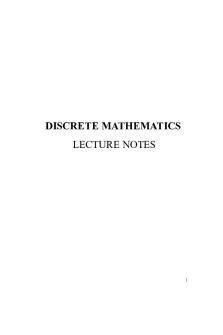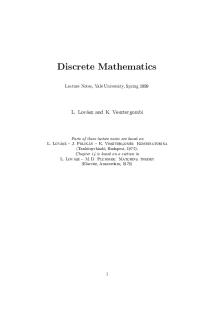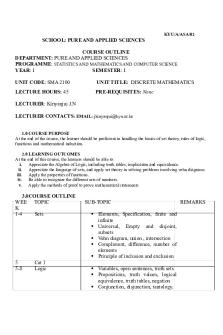Conditional Statements Notes Discrete Mathematics F16 PDF

| Title | Conditional Statements Notes Discrete Mathematics F16 |
|---|---|
| Course | Discrete Mathematics |
| Institution | Lamar University |
| Pages | 3 |
| File Size | 72.4 KB |
| File Type | |
| Total Downloads | 36 |
| Total Views | 161 |
Summary
Discrete Mathematics, Lamar University, Prof. Couch, Fall 2016, Lecture Notes #9...
Description
CONDITIONAL STATEMENTS
CONDITIONAL STATEMENTS MATH 3311 DISCRETE MATH
1
2
CONDITIONAL STATEMENTS
9. Conditional Statements Definition 31. The statement “If p, then q.” is known as a conditional statement. The statement p is called the hypothesis, and the statement q is called the conclusion. The symbol for a conditional statement is p ⇒ q, which may also be read as “p implies q .” p T T F F
q T F T F
p ⇒ q ¬p ¬p ∨ q T F T T Figure 5.
The truth table to the above shows that the only time that the conditional statement p ⇒ q is false is when the hypothesis p is true and the conclusion q is false. The table also shows that p ⇒ q ⇔ ¬p ∨ q . 9.1. Examples. A conditional statement might be thought of as being similar to a promise, where the statement is false only in the case where the promise is broken. (1) “If I win the lottery next Wednesday, then I will buy you a stick of gum.” The only time I would break my promise is when next Wednesday rolls around, I find that I have won the lottery and I don’t buy you a stick of gum. If, when Wednesday rolls around, I find that I didn’t win the lottery, then I can either buy you a stick of gum or not as I choose; in either case, I won’t have broken my promise. (2) “If a polygon is a triangle, then the sum of the measures of its angles is 180◦ .” The hypothesis is “a polygon is a triangle,” and the conclusion is “the sum of the measures of its angles is 180◦ .” This conditional statement is true because when the hypothesis is true, then the conclusion must be true. A logically equivalent statement is “either a polygon is not a triangle or the sum of its angles is 180◦ .” In mathematics, most axioms, definitions, and theorems are stated in the “if, then” form rather than in the “either, or” form. 10. Denials of Conditional Statements We can see from the following table that the useful denial of p ⇒ q is p ∧ ¬q. Since p ⇒ q is logically equivalent to ¬p ∨ q, its useful denial is the same as for ¬p ∨ q . p T T F F
q p ⇒ q ¬(p ⇒ q) ¬q p ∧ ¬q T F T F Figure 6.
CONDITIONAL STATEMENTS
3
10.1. Examples. (1) r ⇔ (p ⇒ q): If John studies for 3 hours, he will pass his math test. p: q: ¬r: (2) r ⇔ (p ⇒ q): If Toronto is the capital of New York, then Boston is the capital of Texas. p: q: ¬r: 10.2. Exercises. Write the denial of each of the following conditional statements. What is the truth value of each statement and its denial? (1) If Manhattan was built in a day, then the Sear’s Tower in Chicago is the tallest building in the world. (2) If the Sun is a star, then Mars is a star also. (3) If Sam Houston was a president of the Republic of Texas, then he was also a governor of the state of Texas. (4) If the Amazon River is in Africa, then the Nile River is in South America. (5) If “broccoli” is the name of a vegetable, then “cabbage” is the name of a fruit....
Similar Free PDFs

Discrete Mathematics -5 Units Notes
- 190 Pages

Discrete mathematics worksheet 2
- 1 Pages

Discrete Mathematics lesson 2
- 2 Pages

MAT 145 - Discrete Mathematics
- 139 Pages

Discrete Mathematics (CS6105)
- 108 Pages

BST Discrete Mathematics
- 3 Pages

Mcs-013 Discrete Mathematics
- 21 Pages
Popular Institutions
- Tinajero National High School - Annex
- Politeknik Caltex Riau
- Yokohama City University
- SGT University
- University of Al-Qadisiyah
- Divine Word College of Vigan
- Techniek College Rotterdam
- Universidade de Santiago
- Universiti Teknologi MARA Cawangan Johor Kampus Pasir Gudang
- Poltekkes Kemenkes Yogyakarta
- Baguio City National High School
- Colegio san marcos
- preparatoria uno
- Centro de Bachillerato Tecnológico Industrial y de Servicios No. 107
- Dalian Maritime University
- Quang Trung Secondary School
- Colegio Tecnológico en Informática
- Corporación Regional de Educación Superior
- Grupo CEDVA
- Dar Al Uloom University
- Centro de Estudios Preuniversitarios de la Universidad Nacional de Ingeniería
- 上智大学
- Aakash International School, Nuna Majara
- San Felipe Neri Catholic School
- Kang Chiao International School - New Taipei City
- Misamis Occidental National High School
- Institución Educativa Escuela Normal Juan Ladrilleros
- Kolehiyo ng Pantukan
- Batanes State College
- Instituto Continental
- Sekolah Menengah Kejuruan Kesehatan Kaltara (Tarakan)
- Colegio de La Inmaculada Concepcion - Cebu








